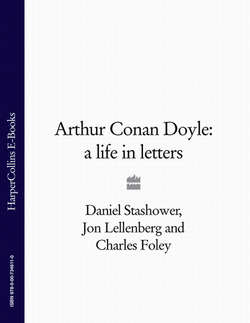Читать книгу Arthur Conan Doyle: A Life in Letters - Daniel Stashower, Исмаил Шихлы - Страница 97
2 The Medical Student (1876-1882)
ОглавлениеTHE MEDICAL LOVE SONG
My heart at each systole swelling Still murmurs its passion for you— The Venous side, dear, is thy dwelling, A temple untainted and true And there by the fossa ovalis Where the mitral your chamber shall screen There ’mid reduced hæmoglobin Oh that is your palace, my queen
—A. CONAN DOYLE, MB CM
Conan Doyle was ‘wild, full-blooded, and a trifle reckless’ when he entered Edinburgh University in October 1876. Edinburgh was famous for literature as well as medicine, and also there at the time were friends of later years, like Robert Louis Stevenson and James Barrie. ‘Strange to think that I probably brushed elbows with them,’
Conan Doyle mused later on; but he found medical school one ‘long weary grind at botany, chemistry, anatomy, physiology, and a whole list of compulsory subjects, many of which have a very indirect bearing upon the art of curing.’
Attending Edinburgh University meant living at home for him—an economy that meant no letters to his mother about the experience. Nor have letters to others about his medical school life been found.
He did look back at Edinburgh in his novel The Firm of Girdlestone, written in the 1880s. She ‘may call herself with grim jocoseness the “alma mater” of her students,’ its narrator muses, but she
conceals her maternal affection with remarkable success… There is symbolism in the very look of her, square and massive, grim and grey, with never a pillar or carving to break the dead monotony of the great stone walls. She is learned, she is practical, and she is useful. There is little sentiment or romance in her composition, however.
A lad coming up to an English University finds himself in an enlarged and enlightened public school… [H]is University takes a keen interest in him. She pats him on the back if he succeeds. Prizes and scholarships, and fine fat fellowships are thrown plentifully in his way if he will gird up his loins and aspire to them.
There is nothing of this in a Scotch University… [Edinburgh] is a great unsympathetic machine, taking in a stream of raw-boned cartilaginous youths at one end, and turning them out at the other as learned divines, astute lawyers, and skilful medical men. Of every thousand of the raw material about six hundred emerge at the other side. The remainder are broken in the process.
In later years, after giving up medicine for literature, he took a more measured view of the experience, and of the value he felt he had derived from it. ‘There are few phases of medical life, from the sixpenny dispensary to the two-guinea prescription, of which I have not had personal experience,’ he told the students at St Mary’s Hospital, London, in a 1910 talk entitled The Romance of Medicine, assuring them that medicine
tinges the whole philosophy of life and furnishes the whole basis of thought. The healthy skepticism which medical training induces, the desire to prove every fact, and only to reason from such proved facts—these are the finest foundations for all thought. And then the moral training to keep a confidence inviolate, to act promptly on a sudden call, to keep your head in critical moments, to be kind and yet strong—where can you, outside medicine, get such a training as that?…And then there is another way in which it acts. It sets a very high standard of strenuous work. You may not consider this altogether an advantage while you do it, but it remains a precious heritage for life. To the man who has mastered Grey’s Anatomy, life holds no further terrors… All work seems easy after the work of a medical education.
What exists in letters are the interstices of his medical studies, from his attempt to win the bursary, through assistantships to several doctors, one of whom became a second father to him, to taking the plunge finally into medical practice of his own, as junior partner to someone he had known at Edinburgh—Dr George Budd, whose methods of practising medicine were controversial, and whose personality was volcanically paranoid. Conan Doyle not only entered Edinburgh at age seventeen, but, in the custom of the day, started studying medicine without further academic ado. During the two months at home after returning from Feldkirch, though, while his mother was away on a visit, he prepared himself to compete for the bursary whose £40 would mean much to him and his family.
